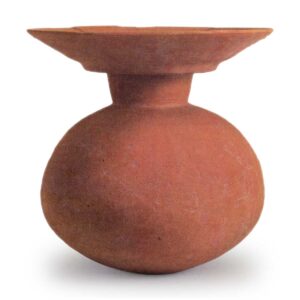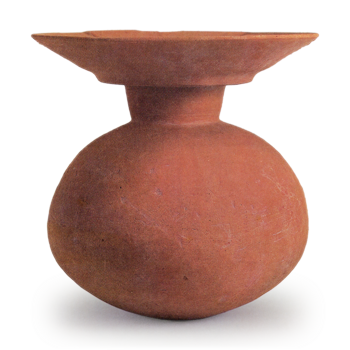
Excavated from Funabashi Site, Kashiwabara-shi, Osaka
4th century
Height 19.1cm, Mouth diameter 18.8cm, Body diameter 17.6cm, Bottom hole diameter 3.0cm
Osaka Prefectural Board of Education
The Funabashi Site is a large village site with a long history from the Late Jomon to the Historic Period, formed at the end of a Pleistocene plateau where the Yamato River flows out into the Kawachi Plain. The site straddles Kashiwabara City and Mireo Town, Minamikawachi-gun, and was buried under the riverbed of the Yamato River during its improvement in 1706.
This jar is one of the oldest types of earthenware in the Kinai region. It has a flattened body with a cylindrical neck and a two-tiered, wide-open mouth rim, similar to the jar-shaped earthenware excavated from the top of the Chausuyama burial mound in Sakurai, Yamato Prefecture. The clay is of good quality, slightly sandy, and both the interior and exterior surfaces have been carefully adjusted by scraping. The firing is not very hard. The bottom is probably a small flat bottom, but this is not clear due to the 3 cm diameter hole. Part of a square engraving remains on the outside of the hole. The hole was drilled after firing. The perforation of the bottom suggests that this vessel was used not as a utilitarian vessel but as a ritual vessel, like the jar-shaped earthenware of the same shape found at the top of the Chausuyama burial mound.



